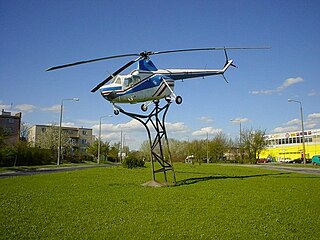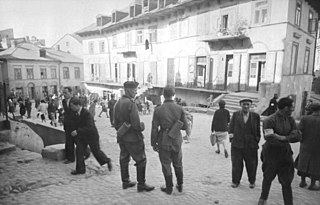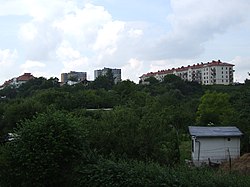
Lesser Poland, often known by its Polish name Małopolska, is a historical region situated in southern and south-eastern Poland. Its capital and largest city is Kraków. Throughout centuries, Lesser Poland developed a separate culture featuring diverse architecture, folk costumes, dances, cuisine, traditions and a rare Lesser Polish dialect. The region is rich in historical landmarks, monuments, castles, natural scenery and UNESCO World Heritage Sites.

Lublin is the ninth-largest city in Poland and the second-largest city of historical Lesser Poland. It is the capital and the centre of Lublin Voivodeship with a population of 336,339. Lublin is the largest Polish city east of the Vistula River and is about 170 km (106 mi) to the southeast of Warsaw by road.

The Lublin Voivodeship, also known as the Lublin Province, is a voivodeship (province) of Poland, located in southeastern part of the country. It was created on January 1, 1999, out of the former Lublin, Chełm, Zamość, Biała Podlaska and (partially) Tarnobrzeg and Siedlce Voivodeships, pursuant to Polish local government reforms adopted in 1998. The region is named after its largest city and regional capital, Lublin, and its territory is made of four historical lands: the western part of the voivodeship, with Lublin itself, belongs to Lesser Poland, the eastern part of Lublin Area belongs to Red Ruthenia, and the northeast belongs to Polesie and Podlasie. Lublin Voivodeship borders Subcarpathian Voivodeship to the south, Świętokrzyskie Voivodeship to the south-west, Masovian Voivodeship to the west and north, Podlaskie Voivodeship along a short boundary to the north, Belarus and Ukraine to the east. The region's population as of 2019 was 2,112,216. It covers an area of 25,155 square kilometres (9,712 sq mi).

Łęczna is a town in eastern Poland with 19,780 inhabitants (2014), situated in Lublin Voivodeship. It is the seat of Łęczna County and the smaller administrative district of Gmina Łęczna. The town is located in northeastern corner of historic province of Lesser Poland. Łęczna tops among the hills of the Lublin Upland, at the confluence of two rivers—the Wieprz, and the Świnka. On December 31, 2010, the population of the town was 20,706. Łęczna does not have a rail station, the town has been placed on a national Route 82 from Lublin to Włodawa. And shall be considered as a start point to Kameralne Pojezierze, as the town has decided to rebrand the lakeland district, from Pojezierze Łęczyńsko-Włodawskie, or Pojezierze Łęczyńskie, to Kameralne Pojezierze.

Lubartów is a town in eastern Poland, with 23,000 inhabitants (2004), situated in Lublin Voivodeship. It is the capital of Lubartów County and the Lubartów Commune. Historically it belongs to Lesser Poland.

Świdnik is a town in southeastern Poland with 40,186 inhabitants (2012), situated in the Lublin Voivodeship, 10 kilometres southeast of the city of Lublin. It is the capital of Świdnik County. Świdnik belongs to the historic province of Lesser Poland, and was first mentioned in historical records in the year 1392. It remained a village until the end of the 19th century when it began to develop as a spa, due to its location and climate.

Puławy is a city in eastern Poland, in Lesser Poland's Lublin Voivodeship, at the confluence of the Vistula and Kurówka Rivers. Puławy is the capital of Puławy County. The city's 2019 population was estimated at 47,417. Its coat of arms is based on Pogonia.

Bielsk Podlaski is a town in eastern Poland, within Bielsk County in the Podlaskie Voivodeship. As of December 2021, the town has a population of 24,883.

Chełm is a city in southeastern Poland with 60,231 inhabitants as of December 2021. It is located to the south-east of Lublin, north of Zamość and south of Biała Podlaska, some 25 kilometres from the border with Ukraine. Chełm used to be the capital of the Chełm Voivodeship until it became part of the Lublin Voivodeship in 1999.

Janów Lubelski is a town in southeastern Poland. It has 11,938 inhabitants (2006). Situated in the Lublin Voivodship, Janów Lubelski belongs to Lesser Poland, and is located in southeastern corner of this historic Polish province. It is the capital of Janów Lubelski County. It has a large hospital. It also has several tourist attractions, including buildings and churches from the 17th and 18th centuries. Janów Lubelski is home to the Open-air museum of the Forest Railway in Janów Lubelski
The Central Industrial District, is an industrial region in Poland. It was one of the biggest economic projects of the Second Polish Republic. The 5-year-long project was initiated by a famous Polish economist, deputy Prime Minister and Minister of the Treasury, Eugeniusz Kwiatkowski. Its goal was to create a heavy industrial center in the middle of the country, as far as possible from any borders, strengthen the Polish economy and reduce unemployment. The four-year plan for the development of COP was scheduled from 1 September 1936 until 30 July 1940 and was interrupted by the outbreak of the Second World War and the German invasion of Poland on 1 September 1939. Nonetheless, the COP project succeeded in vastly expanding Polish industry, and after the end of the war in 1945 COP was rebuilt and expanded under the People's Republic of Poland.

Bełżec is a village in Tomaszów Lubelski County, Lublin Voivodeship, in eastern Poland. It is the seat of the gmina of Gmina Bełżec. It lies approximately 8 kilometres (5 mi) south of Tomaszów Lubelski and 114 km (71 mi) south-east of the regional capital Lublin. It is located in the Roztocze region.

Oksywie is a district of the city of Gdynia, Pomeranian Voivodeship, northern Poland. Formerly a separate settlement, it is older than Gdynia by several centuries.

Gmina Aleksandrów is a rural gmina in Biłgoraj County, Lublin Voivodeship, in eastern Poland. Its seat is the village of Aleksandrów, which lies approximately 16 kilometres (10 mi) south-east of Biłgoraj and 91 km (57 mi) south of the regional capital Lublin.

Modliborzyce is a town in Janów Lubelski County, Lublin Voivodeship, in eastern Poland. It is the seat of the gmina called Gmina Modliborzyce. It lies in the historic province of Lesser Poland, approximately 8 kilometres (5 mi) north-west of Janów Lubelski and 58 km (36 mi) south of the regional capital Lublin. It has a population of 1,311.

Sandomierz Voivodeship was a proposed voivodeship of the Second Polish Republic, which was never created because of the Nazi and Soviet invasion of Poland in September 1939. The idea of the creation of this unit was the brainchild of the Minister of Industry and Trade Eugeniusz Kwiatkowski, and it was directly linked with creation of one of the biggest economic projects of interbellum Poland, Central Industrial Region. It was intended to cover south-central Poland and be created in late 1939. Its projected size was 24,500 square kilometers, and it was to incorporate 20 or 21 powiats.

The Lublin Ghetto was a World War II ghetto created by Nazi Germany in the city of Lublin on the territory of General Government in occupied Poland. The ghetto inmates were mostly Polish Jews, although a number of Roma were also brought in. Set up in March 1941, the Lublin ghetto was one of the first Nazi-era ghettos slated for liquidation during the deadliest phase of the Holocaust in occupied Poland. Between mid-March and mid-April 1942 over 30,000 Jews were delivered to their deaths in cattle trucks at the Bełżec extermination camp and additional 4,000 at Majdanek.
The following is a timeline of the history of the city of Lublin, Poland.

Jasień is a dzielnica of the city of Gdańsk, Poland, located in the southern part of the city, established in 2011.



















